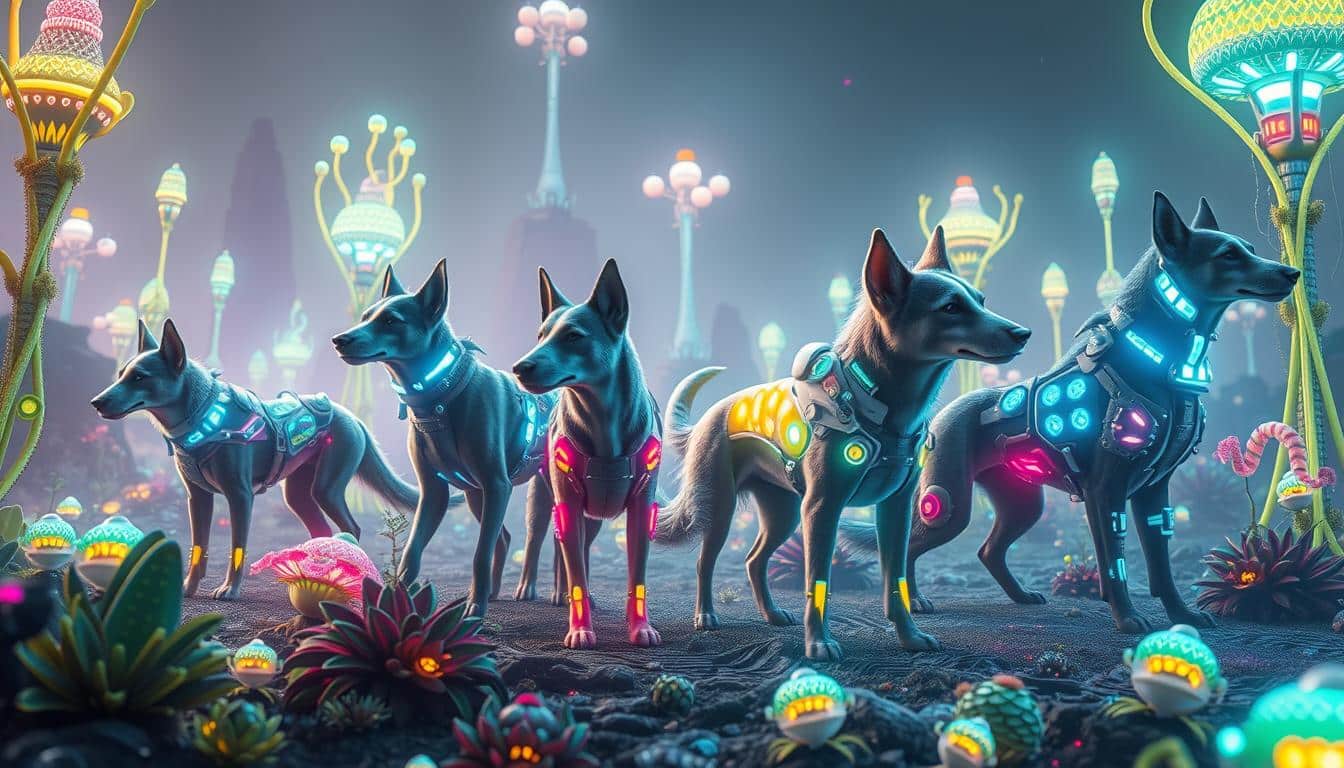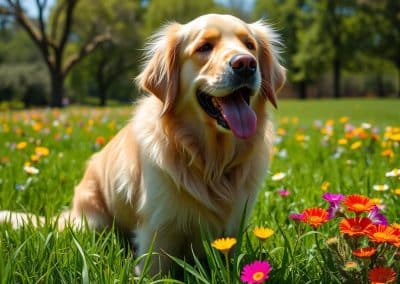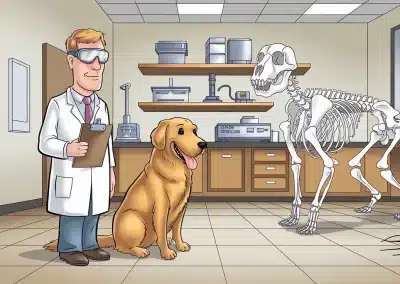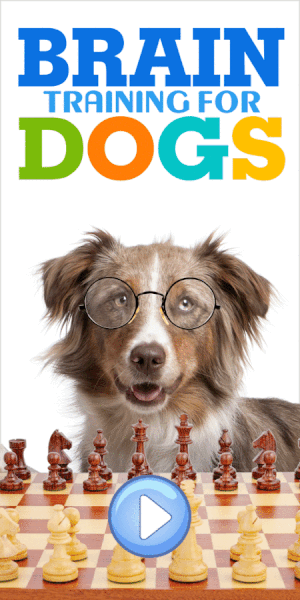Dogs are entering a new stage of evolution. I’ve always been amazed by the bond between humans and dogs. Recently, I’ve seen a big change in how we see and treat our dogs. They’re changing to meet our modern needs. This change is exciting and has big implications for our relationship with dogs.
Scientists say dogs might be going through a new phase of domestication. We want them to be calmer and friendlier. No longer just for hunting or herding, dogs are now part of our families. They fit well into our urban, sedentary lives.
Key Takeaways
- Dogs are undergoing a transformative shift in their domestication, driven by societal demand for calmer, more affectionate companions.
- Genetic studies reveal that certain genetic variants in dogs are linked to increased social bonding and help-seeking behaviors.
- The evolution of dogs is entering a third wave, with a focus on tailoring their personalities to thrive in modern, urban environments.
- Service dogs represent the most advanced stage of this canine cognitive revolution, exhibiting unique dispositions and trainability.
- The future of our furry friends lies in their ability to adapt to the changing needs of their human counterparts, fostering an even deeper interspecies bond.
The Evolutionary Shift: Companions over Workers
Just decades ago, dogs were seen as working animals. They hunted pests, herded livestock, and guarded homes. Now, they are cherished companions. This change is linked to a hormone that boosts social bonding, especially in service dogs.
From Hunting Prowess to Couch Companions
The story of dogs evolving from wolves is fascinating. Scientists debate how humans domesticated wolves. Some say it was from scavenging, others from caring for wolf puppies.
Wolves changed physically as they worked with humans. They grew smaller and had shorter jaws. Wolves that got along with humans were more likely to travel and pass on their genes.
The bond between humans and dogs grew over thousands of years. Wolves started living near humans to eat food leftovers. This close interaction helped wolves become more social and bond with humans.
| Key Evolutionary Shifts | Implications |
|---|---|
| Transition from working animals to companions | Increased levels of the “love hormone” oxytocin, fostering stronger social bonds |
| Physical changes in wolves, leading to the modern dog | Smaller skeletal frames, shortened jaws, and enhanced sociability |
| Increased social attentiveness and cooperation with humans | Improved communication and collaboration in diverse activities |
The journey of dogs from hunting companions to beloved pets is amazing. It shows the strength of human-animal cooperation and coevolution. As we learn more about this bond, we see how much our pets enrich our lives and the world.
Oxytocin: The Love Hormone Driving Social Bonding
When humans domesticated wolves, they became the loving pets we know today. Dogs’ sensitivity to oxytocin, the “love hormone,” has grown. This change helps dogs form strong bonds with their human friends.
Research shows that dogs’ oxytocin levels go up after they bond with others. This is similar to other social mammals like baboons and dolphins. These animals also form strong bonds, which helps them live longer and have healthier offspring.
Studies have also shown that oxytocin helps dogs feel closer to their owners. Dogs given oxytocin spray act more friendly towards their owners than those given a placebo. This shows oxytocin’s key role in dog-human relationships.
The changes from wolves to domesticated dogs have affected their minds and social skills. Dogs now better understand human emotions and social cues. Oxytocin plays a big part in this connection between humans and dogs.
The bond between humans and dogs is more than just training. It’s rooted in genetic and physiological changes from domestication. Knowing how oxytocin affects dog behavior helps us understand our special bond with them.
Dogs are entering a new stage of evolution
Adapting to the Urban, Sedentary Lifestyle
Dogs have changed from working animals to beloved pets. Their behavior and biology have adapted to the modern, urban lifestyle. In the past, dogs spent most of their time outdoors, exploring. Now, with more urban living, dogs spend more time indoors, meeting new people and dogs.
This change has made some behaviors that were once good now seem bad. Dogs are now friendlier and calmer, as humans want more affectionate pets. A study found that dogs with a certain gene are more affectionate towards their owners.
Service dogs are a great example of this change. They are known for their calmness and ability to help their owners. Unlike regular pets, service dogs are friendly to strangers from a young age. This shows they are more sociable, a trait that is encouraged in them.
“Over generations, natural selection for friendliness in dogs replaced fear and aggression towards humans.”
The impact of urban living on dogs is complex and ongoing. As dogs spend more time indoors, their behavior and biology keep changing. This change is leading to a new stage of dog evolution, focusing on companionship and social bonding.
Service Dogs: Pioneers of the Third Wave
As society changes, so do our dogs. Service dogs lead the way in this new era. They are different from regular pet dogs because they like meeting new people, even when they’re young. This change in behavior is similar to how dogs changed thousands of years ago when they first became domesticated.
A 2017 study showed that service dogs have more oxytocin than regular pet dogs. Oxytocin helps us bond with others. This means that the special training and socialization service dogs get might be changing their biology and behavior. It’s like they’re starting a new chapter in dog evolution.
Training and socialization are key in shaping service dogs. They learn to handle many situations and people from a young age. This training helps them become amazing helpers in many areas, like helping people with disabilities or offering comfort when needed.
| Characteristics of Highly Trained Service Dogs | Benefits to Humans |
|---|---|
| Heightened social attunement and responsiveness | Improved quality of life for individuals with disabilities or mental health challenges |
| Specialized task-oriented skills (e.g., guiding, alerting, retrieving) | Enhanced independence and safety for those in need |
| Calm, patient, and focused temperament | Increased comfort and emotional support in stressful situations |
Service dogs are leading us into a new era of dog domestication. They show us the incredible connection between humans and dogs.
“Service dogs are the exception and the answer to the domestication puzzle. Unlike most pet dogs, service dogs are attracted to strangers, even as puppies.”
Evolutionary History: From Foragers to Middle Class
The First and Second Waves of Domestication
Dogs have been part of human lives for 40,000 to 14,000 years. The first wave started when humans were foragers, leaving food waste outside their homes. Wolves that ate this food became the first domesticated dogs.
The second wave happened after the Industrial Revolution. The growing middle class wanted dogs as status symbols. This led to the creation of over 200 dog breeds we know today.
“Dogs were likely domesticated twice, once in Asia and once in Europe or the Near East, with the European ancestry mostly vanished from today’s dogs.”
The oldest dog remains were found in Siberia, dating back to 12,380 BP. The first dog burials were in Japan during the Jomon period, around 9,500 BP.
As the middle class expanded, so did the demand for specific dog breeds. This led to the development of unique breeds like the Chin and Ryukyu dogs in Japan.
Industrialization greatly changed dog breeding. It turned dogs from working animals to status symbols and pets.
Breeding for Friendliness: A New Approach
Dog lovers are changing their focus. They now care more about a dog’s personality and how well it gets along with others. This shift could greatly change the future of dogs.
Studies like the Russian fox domestication show the power of selective breeding. In just a decade, foxes became more friendly and changed physically. They started to wag their tails and show more interest in humans.
If more people want dogs that are friendly and loving, breeders will listen. This could lead to dogs that are not only more affectionate but also look different. We might see a big change in how dogs look and act over time.
| Characteristic | Wild Wolves | Domesticated Dogs |
|---|---|---|
| Sociability | Low | High |
| Aggression | High | Low |
| Fearfulness | High | Low |
| Attachment to Humans | Low | High |
This new focus on friendliness in dog breeding is a big change. It could lead to dogs that are not just different-looking but also better suited to our lives. We might see dogs that are more suited to living in cities and being part of our families.
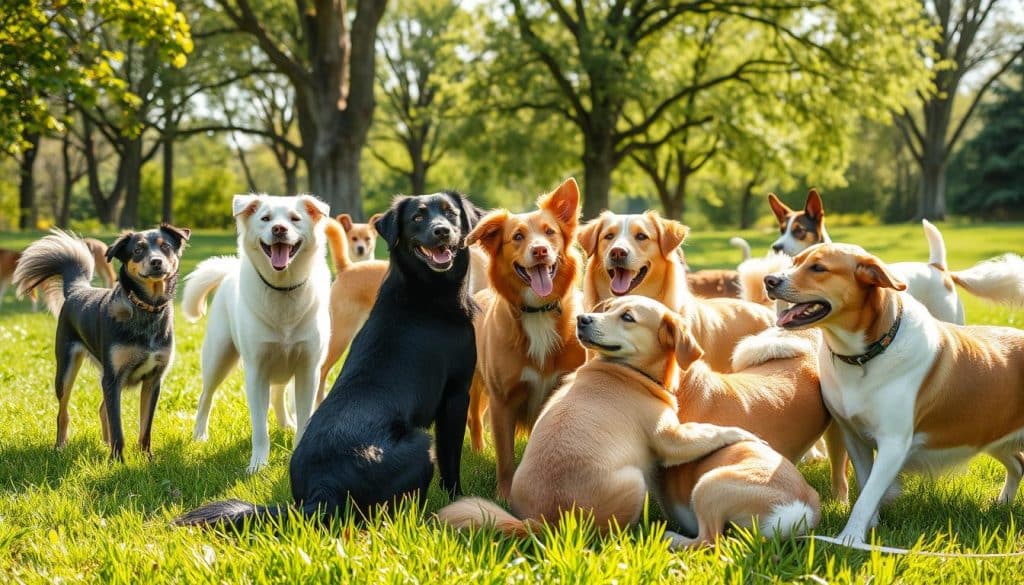
“The Russian experiment with foxes showed that selecting for friendly behavior can lead to dramatic changes in physical appearance within just a few generations. This suggests the potential for rapid evolution in dog populations when breeders prioritize personality over physical traits.”
The Role of Training and Socialization
Training and socialization are key for a dog’s development. A 1961 study showed that puppies need human contact early to bond with humans. As dogs adapt to our modern lifestyle, training and socialization are vital for their happiness and fitting in.
Positive Reinforcement and Early Exposure
Puppies go through three important social stages. The first is from birth to 3 weeks, the second from 3 to 12 weeks, and the third from 12 weeks to adulthood. It’s crucial to expose them to many people, animals, and places during these times.
Experts suggest several ways to socialize puppies at home. These include crate-training, positive reinforcement, short walks, and introducing them to various people and situations. These practices help dogs adjust to our world and deal with stress better.
Early exposure to new things is very important. It helps puppies learn what is safe and what is not. This reduces fear and improves their overall health.
“Proper handling and socialization of puppies early in life lead to long-term benefits, contributing to improved behavior and resilience to stress as adults.”
The number of dogs is growing, with 92.9 million in Europe and 2.5 million in the UK each year. Training and socialization are more important than ever. By focusing on these, we can help our dogs thrive in today’s world.
Canine Cognitive Revolution: Interspecies Coevolution
The bond between dogs and humans has grown in amazing ways. Service dogs show how dogs have become more social and understanding of human needs. This change is thanks to a long history of dogs and humans evolving together.
Studies show dogs’ brains have changed because of their close ties with humans. Modern human behavior and culture started to emerge between 100 to 50 thousand years ago. This is when dogs’ brains likely got better at social skills and working together.
Scientists are figuring out how dogs’ brains got smarter. They found that dogs’ brains work differently than humans’ when it comes to aggression and learning. This shows how dogs and humans have influenced each other’s brains.
Dogs and humans have a special bond that affects many areas of life. Being around dogs can calm our minds and make us feel more connected. This bond has shaped art, culture, and how we see ourselves.
The story of dogs and humans is one of incredible adaptability and intelligence. From hunting to being family pets, dogs have grown with us. They’ve helped shape our history and culture in big ways.
“The neurological effects of close interactions with dogs may include enhanced social attunement, emotional openness, and higher cognitive functions in humans.”
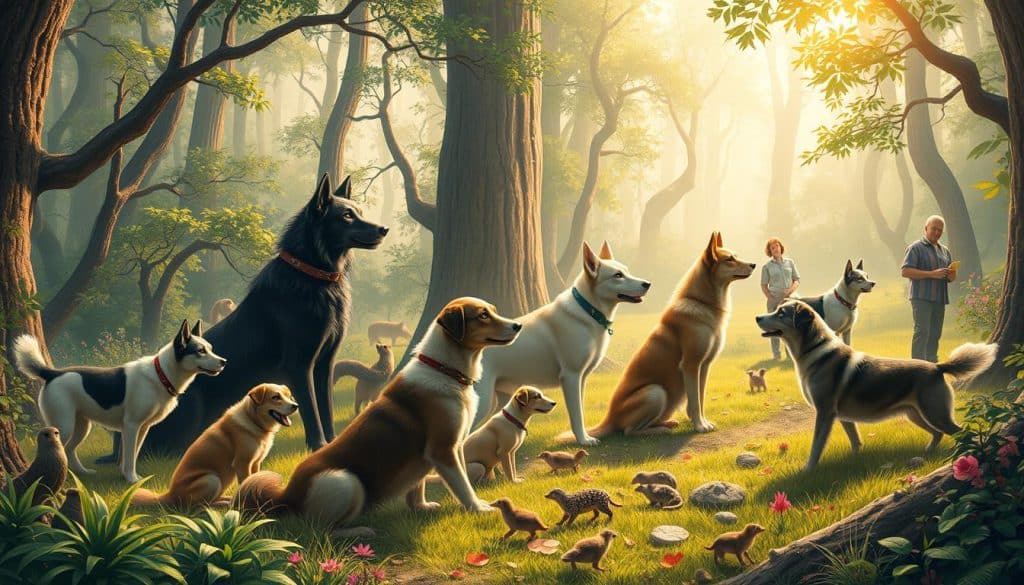
Furry Companions’ Future: Adapting to Modern Life
The world is changing fast, and so is the future of domesticated dogs. Humans need to adapt dog domestication to fit modern lifestyles. This new wave of dog domestication is underway, and we must help dogs adapt to our urban, sedentary lives.
The adaptation of dogs to modern lifestyles is key. The impact of human preferences on canine evolution is big. By training dogs like service animals, we can help them in the modern world. This change will benefit dogs and strengthen our bond with them, a bond over 15,000 years old.
Dogs are incredibly adaptable. With the right training, they can excel in our modern world. Let’s embrace this new era of dog domestication. This way, our furry friends will always be a big part of our lives.
FAQ
What evidence suggests that dogs are entering a new stage of evolution?
How has the role of dogs in our lives changed over time?
What is the role of oxytocin in dog domestication?
How are modern dogs adapting to urban, sedentary lifestyles?
How do service dogs differ from the average pet dog?
What are the historical waves of dog domestication?
How can selective breeding for friendliness impact dog evolution?
What methods can be used to help dogs adapt to modern life?
How does the coevolution of dogs and humans impact canine cognitive development?
What is the future of domesticated dogs as they adapt to modern life?
Source Links
- Dogs May Be Entering A New Phase Of Evolution Due To Modern Human Life, According To Scientists
- Scientists discover dogs are entering a new phase of evolution
- How Dogs Evolved Into ‘Our Best Friends’
- Tracking the evolutionary origins of dog-human cooperation: the “Canine Cooperation Hypothesis”
- How dogs and humans became best friends | CBC Documentaries
- Oxytocin promotes social bonding in dogs
- Exploring women’s oxytocin responses to interactions with their pet cats
- Dogs Are Entering a New Wave of Domestication
- A History of Dogs in the Early Americas
- The State of Animal-Assisted Interventions: Addressing the Contemporary Issues That Will Shape the Future
- History of Guide Dogs – International Guide Dog Federation
- The dog-human connection in evolution
- The origin of dog domestication and dog breeds of Japan
- Being a Dog: A Review of the Domestication Process
- Did breeding or natural selection create the dog? – Pints of History
- Puppy parties and beyond: the role of early age socialization practices on adult dog behavior
- Canine Socialisation: A Narrative Systematic Review
- Did Dog Domestication Contribute to Language Evolution?
- Dogs & People: Neuroscience of Man’s Best Friend & Evolutionary Ally — Ultra Unlimited
- The animals that may exist in a million years, imagined by biologists
- The History of Dogs: From Wolves to Man’s Best Friend | SchoolTube

